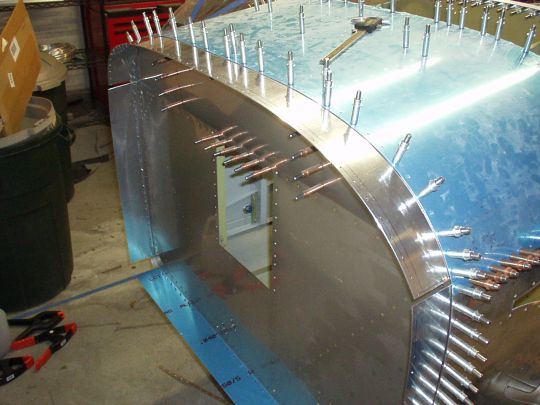|
  

Cowling
Running Total Hours:
0.0
 | 2009.06.27: (0.0)
I'm not really working on the cowl itself yet, but this is a
convenient time to start thinking about the cowling attachment
method. Van's standard method uses piano hinges to secure the
cowling halves to the fuselage and to each other. This approach
is clean and simple in principle, but has been plagued by some common
problems in the field. Firstly, the joint along the top is both
heavily curved, and moderately conical. To make this work at
all, builders generally have to 1) file down the hinge eyelets, and 2)
use an undersized hinge pin. This tends to make for a loose and
sloppy fit. Secondly, the joint along the bottom has a tendency
to crack and lose hinge eyelets over time. And thirdly, the
builder has to make provisions for accessing as well as securing all
the hinge pins, which tends to get a bit messy.
Given these problems, many builders have opted for either screws and
nut plates, or quarter-turn fasteners ("camloc") to secure
the cowling instead of hinges. In particular, two companies, MilSpec
and SkyBolt,
produce quarter-turn fastener kits for RV cowlings that have become
quite popular. I will likely end up going with one of these
options.
While I'm not committing to any of these yet, I went ahead and created
the flanges at the firewall that would be used for any of these
systems. My flanges are made of 2024-T3 0.040" alclad, and
for now they extend about 2.5 inches forward of the fuselage
skin. They will ultimately get trimmed to approx 1.5 inches, and
possibly scalloped between fasteners as needed (hopefully not).
I was careful when fitting these to make them parallel to the fuselage
skins as best I could. For the top flange, this meant I actually
had to trim a slight curve to its aft edge to accomodate the conical
contour. (Most builders end up scalloping the top flange and
bending the individual tabs, I suspect because they neglected to match
the conical contour when originally fitting the flange to the
fuselage. My hope is to avoid this.)

(Photo note: Ignore the holes drilled along the forward edge of the
top and left side flanges. These were unsatisfactory first
attempts, so I turned the flanges around and re-did it to my
satisfaction. About an inch will get trimmed away from the
forward edges anyway, which includes those holes.)
Note that Van's shows some 0.020" shims between the firewall
flanges and the hinges (which in my case would be these flanges) to
match the thickness of the fiberglass cowl. But measuring it
myself, I think I'll actually have a closer match without these
shims. And anyhow I'd rather err on the side of having the
fiberglass cowl protrude beyond the fuselage skin rather than the
other way around, for lower drag. |

  
|
|